Explanation, Example Solved Problems | Algebra | Maths - Division of Polynomials | 9th Maths : UNIT 3 : Algebra
Chapter: 9th Maths : UNIT 3 : Algebra
Division of Polynomials
Division of Polynomials
Let us consider
the numbers 13 and 5. When 13 is divided by 5 what is the quotient and remainder.?
Yes,
of course, the quotient is 2 and the remainder is 3. We write 13 = (5×2)+3
Let
us try.
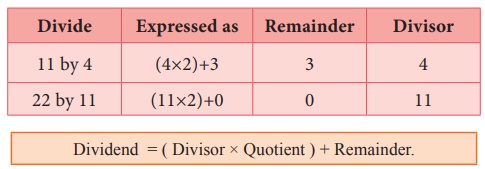
Dividend = ( Divisor × Quotient ) + Remainder.
From
the above examples, we observe that the remainder is less than the divisor.
1. Division Algorithm for Polynomials
Let
p(x) and g(x) be two polynomials such that degree of
p(x) > degree of g(x) and g(x)
≠ 0.
Then
there exists unique polynomials q(x) and r(x) such that
p(x)
= g (x ) × q (x ) + r (x ) … (1)
where
r(x) = 0 or degree of r(x) < degree of g(x).
The
polynomial p(x) is the Dividend, g(x) is the Divisor,
q(x) is the Quotient and r(x) is the Remainder. Now
(1) can be written as
Dividend
= ( Divisor × Quotient ) + Remainder.
If r(x) is zero, then we say p(x) is
a multiple of g(x). In other words, g(x) divides p(x).
If it
looks complicated, don’t worry! it is important to know how to divide polynomials,
and that comes easily with practice. The examples below will help you.
Example 3.32
Divide x3 − 4x2 + 6x by x, where , x ≠ 0
Solution

Example 3.33
Find the quotient and the remainder when (5x2 − 7x + 2) ÷ (x − 1)
Solution
(5x2
− 7x + 2) ÷ (x − 1)
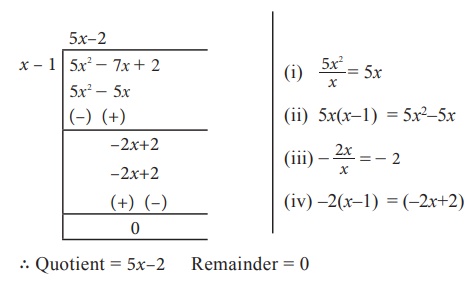
∴
Quotient = 5x–2
Remainder
= 0
Example 3.34
Find quotient and the remainder when f(x) is divided
by g(x)
(i) f(x) = (8x3–6x2+15x–7),
g(x) = 2x+1.
(ii) f(x) = x4 –3x3
+ 5x2 –7, g(x) = x2 + x
+ 1
Solution
(i) f(x) = (8x3–6x2+15x–7),
g(x) = 2x+1
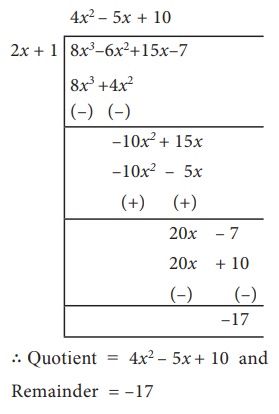
(ii) f(x) = x4 –3x3
+ 5x2 –7, g(x) = x2
+ x + 1
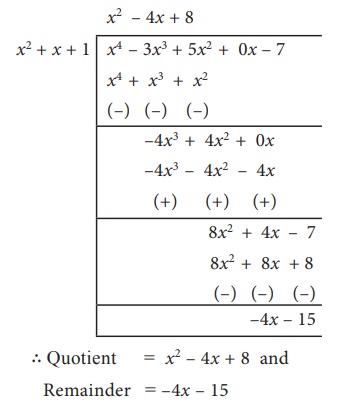
2. Synthetic Division
Synthetic Division is a shortcut method of polynomial division. The advantage of synthetic division is that
it allows one to calculate without writing variables, than long division.
Example 3.35
Find
the quotient and remainder when p(x ) =
(3x 3 −2x 2 –
5 + 7x)
is divided by d(x) = x + 3 using synthetic division.
Solution
Step 1
Arrange dividend
and the divisor in standard form.
3x
3 − 2x2 + 7x −5 (standard form of dividend)
x
+
3 (standard form of divisor)
Write
the coefficients of dividend in the first row. Put ‘0’ for missing term(s).
3 −2 7 −5 (first row)
Step 2 Find out the zero of the divisor.
x +
3 = 0 implies x = −3
Step 3 Write the zero of divisor in front of
dividend in the first row. Put ‘0’ in the first column of second row.

Step 4 Complete the second row and third row
as shown below.

All
the entries except the last one in the third row are the coefficients of the quotient.
Then
quotient is 3x 2 −11x + 40 and and
remainder is -125.
Example 3.36
Find
the quotient and remainder when (3x 3 − 4x2
− 5) is divided by (3x+1) using synthetic division.
Solution
Let
p(x) = 3x3 − 4x2 − 5, d(x)
=
(3x +1)
Standard
form: p(x) = 3x 3 −
4x2 + 0x −5
and
d (x) = 3x +1
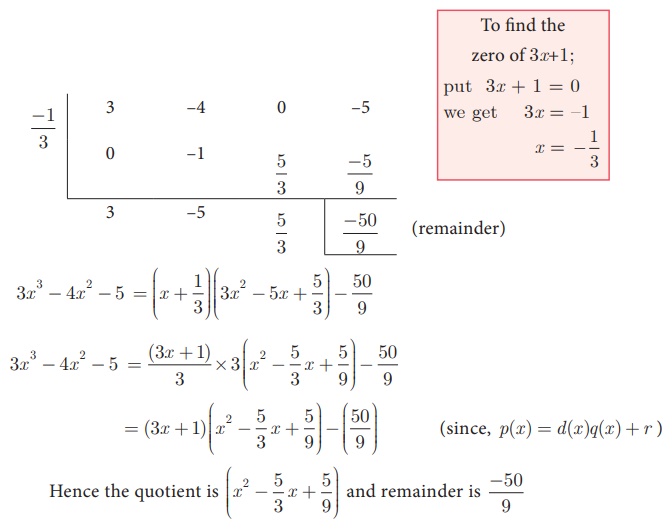
Example 3.37
If the
quotient on dividing x4 + 10x3 +
35x2 + 50x +
29 by (x + 4) is x3 −
ax2 +bx + 6 , then find the value of a,
b and also remainder.
Solution
Let
p(x) = x4 +10x3 +
35x2 +
50x +
29
Standard
form =
x4 +10x3 +
35x2 +
50x +
29
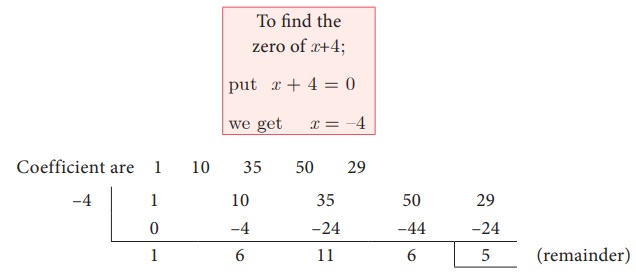
quotient
x 3 + 6x2 +11x
+
6 is compared with given quotient x 3 −
ax 2 +bx + 6
coefficient
of x2 is 6 = −a and coefficient of x is 11 =
b
Therefore,
a = −6 , b =
11 and remainder = 5 .
Related Topics